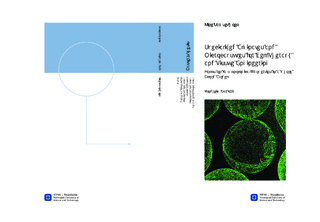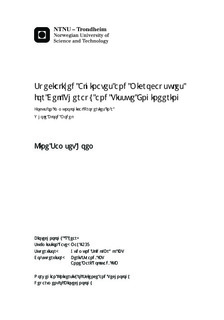| dc.description.abstract | Alginates are a group of abundant natural polysaccharides with excellent gel-forming capacity and good biocompatibility, provided they are sufficiently well purified. Alginate shows great promise as an encapsulation material for the purpose of immunoisolating therapeutic cell transplants, such as insulin-producing cells for the treatment of type 1 diabetes mellitus. Recently, alginates have also been implicated for making novel extracellular matrix (ECM)-like bioscaffolds in tissue engineering. An absolute requirement for successful graft function is that the biomaterial or microcapsule itself does not evoke inflammatory reactions. Thus, developing an understanding of the basic mechanisms leading to bioincompatibility of biomaterials in vivo is necessary in order to create improved artificial organs and tissue. To do this, the stimulatory properties of different biomaterials can be explored in vitro. A lepirudin-based human whole blood model was used to demonstrate the inflammatory potential of a set of different alginate microcapsules and microbeads. This was done in order to elucidate the effect of introducing different properties into the alginate system, e.g. hydroxyapatite (HA) mineralization – as intended for uses in bone tissue engineering , and covalent grafting with peptides – as intended for producing ECM-like materials for general tissue engineering strategies. Furthermore, other microcapsules and microbeads proposed as immunoisolation devices in transplantation were also examined. Complement activation in terms of sTCC, secretion of chemokines, pro- and anti-inflammatoy cytokines and growth factors, as well as leukocyte activation in terms of CD11b-expression was measured. Confocal laser scanning microscopy (CLSM) was used in order to visualize receptor expression on attached cells and protein deposition on the capsule surfaces. The HA-containing microbeads were found to possess slight immunostimulatory properties. This was especially true for microbeads mineralized through counter-diffusion precipitation, which induced significant leukocyte activation in terms of CD11b-expression, and also noticeably high levels of certain cytokines, e.g. the chemokine MCP-1. Furthermore, these microbeads significantly induced complement activation in terms of sTCC, which was also true for the microbeads mineralized by the use of alkaline phosphatase enzymes. Ca/Ba alginate microbeads (TAM) generally appeared non-inflammatory, and did not induce leukocyte activation, complement or cytokine secretion. Peptide-coupled microbeads covalently grafted with the cell adhesion motifs RGD and REDV, respectively, did generally not induce complement or leukocyte activation, nor cytokine induction, and were overall considered as non-inflammatory. Only the microbeads made from REDV-coupled alginate induced significant cytokine secretion, in terms of IFN-gamma and IL-10. On the other hand, microbeads made from VAPG-coupled alginate induced potent inflammatory responses; however, this effect was most likely linked to a substantial endotoxin contamination. In comparison, polycation-containing microcapsules induced potent inflammatory responses in terms of significant levels of leukocyte(CD11b) and complement activation, as well as elevated cytokine levels. Another part of this thesis aimed to get a mechanistic understanding of phenomena related to differences in the stimulatory effects of solid versus hollow microcapsules. Liquefying the capsule core was observed to decrease the immunostimulatory properties of PLL-containing microcapsules in terms of reduced complement protein deposition, cell adhesion and IL-8 secretion. In contrast, a more potent sTCC increase was detected for these hollow PLL-containing microcapsules as compared to those with a solid core. This could potentially be due to a hypothesized soluble molecule leaking out from the hollow microcapsules and triggering TCC formation in the fluid phase. By employing the C3-specific complement inhibitor compstatin, microcapsules with a liquefied core were further demonstrated to rely on complement activation for cytokine induction. Moreover, hollow microcapsules containing PLO as a polycation showed more promising properties in terms of lower complement activation as compared with PLL-containing hollow microcapsules. In terms of studying the mechanisms leading to cytokine secretion, inhibiting the CD11b/CD18 complement receptor was not found to reduce IL-8 levels, likely due to a stimulatory effect of the CD11b-inhibitory antibody itself. Furthermore, whether the inhibition of phagocytosis with cytochalasin D affected the IL-8 release could not be concluded due to a toxic effect of the ethanol in which the cytochalasin was solubilized. | nb_NO |

